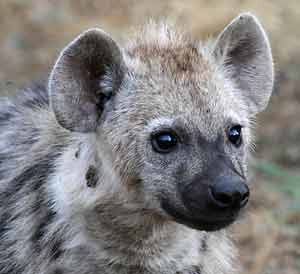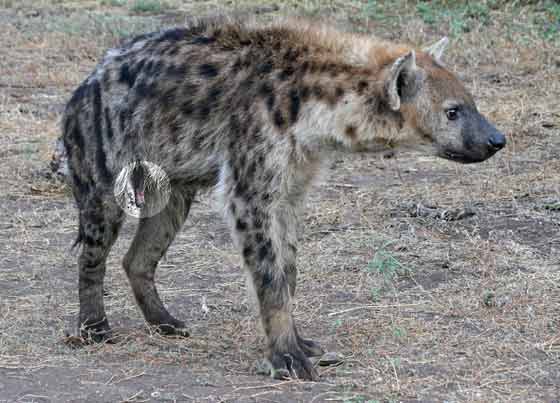Contact Details: Scotch Macaskill, Dirt Road Traders, Currys Post Road, Howick, KwaZulu-Natal, South Africa. Tel: +27 (0)82 578 2329. Privacy: Your privacy is guaranteed. See our Privacy Policy for more. This site accepts advertising and other forms of compensation - see Disclosure and Advertising for details. Site updated: 2022. Copyright © 2002 - 2022 Scotch Macaskill

| ||||||||||
|
||||||||||
|
SEE ALL
|
Spotted Hyenas Burdened with Hermaphrodite Mythby Roddy SmithA group of earnest elderly Americans, visiting Mwambashi River Lodge in Zambia, were escorted by a well-known safari guide to the rich and famous who gave them a series of lectures on African wildlife. He is well-respected and extremely knowledgeable, so I was astonished to hear him tell his clients not once but several times that: "Hyenas are hermaphrodites." This long-established and persistent myth arose because female spotted hyenas (Crocuta crocuta) have what are to all appearances male genitalia. It is nevertheless a myth: males cannot conceive or give birth to young, and females cannot sire them. This is lucky for the males as it gives the females a reason to tolerate their presence. They aren't needed for protection or even really for hunting, as females are bigger and more aggressive than males, have equally high testosterone levels, and are dominant over them in any social situation. Males wishing to mate with females approach with great caution and spend a long time essentially begging to be accepted (something not unknown in human society). The females' "penis" is in fact an enlarged, erectile clitoris the same size, shape and position as the male's penis through which they urinate, mate and give birth, and in place of a vagina they have a scrotum-like pouch.
Internally however they have standard mammalian female plumbing with ovaries and a uterus, but the uro-genital tract instead of exiting under the tail does a U-turn in the pelvis and passes through the tubular clitoris. This is where the females pay their dues for their status; at birth the cubs have to pass about 60cm (the umbilical cord is only about 12cm long) through this tube, which in a first-time mother is much too tight for them to fit through and tears in the process. This is exacerbated by the fact that the cubs are born after an unusually long gestation period by predator standards and are correspondingly large and well-developed. First-time birthing is a painful and dangerous experience for mother and offspring alike and there is a high mortality rate. The torn clitoris doesn't heal closed afterwards so subsequent births are easier and less dangerous, and the torn parts will appear pink which is one way for the observer to tell the gender of mature adults. Ruthlessly CompetitiveThese bizarre characteristics are unique to spotted hyenas and may have evolved as a result of the ruthlessly competitive nature of spotted hyena society. Spotted hyenas are the most efficient utilisers of carcases of any predator, being able to digest flesh, skin and bone completely. As a result they tend to be the most numerous large predator in natural African ecosystems, and the large numbers which congregate at any kill or carcass compete fiercely for food. The strongest and most aggressive eat their fill, while weaker individuals get less or nothing. Cubs obviously cannot compete at carcasses and so they are suckled until about a year old and sometimes longer (which also may be why fewer hyena cubs die of starvation than those of other co-operative hunters like lions and wolves), but to produce enough milk to feed them the mothers have to be strong enough and aggressive enough to compete successfully with other adults at kills. This system favours the most aggressive animals, and pregnant spotted hyenas produce and pass on to their foetuses very high quantities of androgens (male hormones) which raise animal aggression levels, but they also cause even females to develop male genitalia. Competition between spotted hyenas starts literally from birth; they are born precocial with well-developed teeth, and they start fighting in the den within minutes to establish dominance. 
Spotted hyena pup - "quite cute little animals" Once they have sorted out who's who in the zoo they are quite cute little animals. (A friend who raised one said it was a very affectionate and playful pet; on walks it loved to run ahead and hide next to the path and ambush him, but just like a small child playing hide-and-seek always gave its hiding place away by giggling with excitement as he approached.) The off-spring of several different females may live in the same den, but competitive in this as in everything females will not suckle any cubs but their own. (This is in contrast to the behaviour of lions; lactating lionesses are sometimes known to suckle the off-spring of other mothers.) Female spotted hyenas, like baboons, inherit their dominance status from their mothers and these matrilineal rankings may stay virtually unchanged for generations. Any male, however, is inferior in status to any female. See also Spotted Hyena Information for facts and general info about these animals. Roddy Smith is a wildlife conservationist and safari guide based in the Lower Zambezi National Park, Zambia. Images © Scotch Macaskill Return to Wildlife Articles |
|||||||||
|
|
||||||||||
